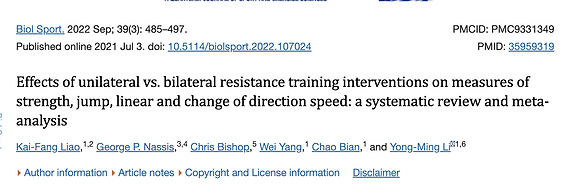
Strength Gains:
Unsurprisingly, one of the key findings of the review was that both unilateral and bilateral resistance training interventions led to significant improvements in strength measures. However, the analysis revealed that bilateral training demonstrated a slightly greater effect on maximal strength gains compared to unilateral training. This is primarily attributed to the increased activation of synergistic muscles and neural adaptations that occur when both limbs are engaged simultaneously.
Jump Performance:
Jumping ability is a crucial determinant of athletic performance. The review highlighted that both unilateral and bilateral resistance training had positive effects on jump performance, particularly in terms of vertical jump height and power. However, when comparing the two training modalities, bilateral training showed a slight advantage in eliciting greater improvements in vertical jump performance. The increased activation of the lower limb muscles during bilateral exercises likely contributes to enhanced explosive power.
Linear Speed:
Again, the findings of the review indicated that both unilateral and bilateral resistance training interventions can improve linear speed to a similar extent. Unilateral training, focusing on the individual limb, has been shown to improve stride length and stride frequency, which are essential determinants of sprinting speed. On the other hand, bilateral training enhances muscular power and coordination, leading to improvements in overall running speed.
Change of Direction Speed:
Change of direction speed, commonly assessed through agility tests, is crucial for sports that involve rapid changes in movement direction. The meta-analysis revealed that both unilateral and bilateral resistance training interventions significantly improved change of direction speed. However, unilateral training appeared to have a slightly greater effect on agility performance. Unilateral exercises require greater stabilization and control from individual muscles, which can enhance an athlete’s ability to decelerate, change direction, and accelerate again quickly.
In summary, based on the systematic review and meta-analysis, both unilateral and bilateral resistance training interventions have positive effects on measures of strength, jump performance, linear speed, and change of direction speed. While bilateral training may lead to slightly greater improvements in maximal strength and vertical jump height, unilateral training may offer a slight advantage in terms of change of direction speed. It is important to note that the choice between unilateral and bilateral training should be based on individual goals, sport-specific requirements, and the patient’s needs. Therefore, sports physiotherapists and strength and conditioning coaches should carefully consider these factors when designing exercise programs to optimise outcomes for their patients.
Remember, it is always recommended to consult your qualified Praxis physiotherapist before starting any exercise program, especially if you have pre-existing medical conditions or injuries. We can provide personalised guidance and ensure that your training program aligns with your specific needs and goals.
Until next time,
Praxis What You Preach
